Health Benefits of Vajrasana Pose and How to Do It

Shamlee Pathare
July 7, 2023

Shamlee Pathare
July 7, 2023
Vajrasana is a culmination of two Sanskrit words – ‘vajra’ and ‘asana’. Vajra means thunderbolt and refers to the weapon of Lord Indra in Hindu mythology. It is a symbol of strength and indestructibility.
Asana means posture in yoga. Vajrasana is one of the easiest asanas and is perfect for beginners. It provides strength to the body and calms the mind.
Vajrasana, also called thunderbolt or diamond pose, is one of the simplest yoga asanas. It is believed to make the body strong as a diamond.
This is arguably the best asana to cure any stomach-related ailments. It is the only asana in yoga that you can perform immediately after a meal.
People of any age can perform this asana easily. Therefore, it has great health benefits and strengthens your digestive organs and improves overall health. Moreover, it also elongates your spine, which improves your posture.
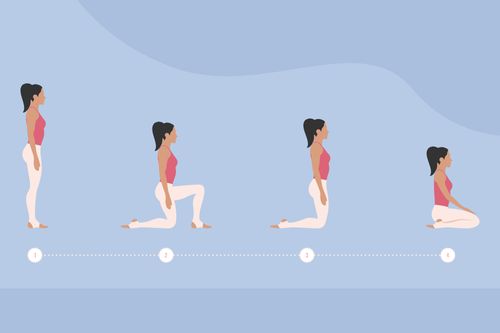
Vajrasana is simple, but it is extremely important to do it correctly. Follow these steps to perform the diamond pose perfectly.
1 – Sit down on a flat floor or yoga mat.
2 – Fold the knees and ankles backwards and point the feet in line with your legs. The bottoms of the feet should face upward touching the big toes.
3 – Buttocks should rest on the heels and thighs should rest on your calves.
4 – Keep your spine, neck and head straight.
5 – Keep your head straight and gaze forward. Keep your chin parallel to the floor.
6 – Keep the right palm on the right knee and the left palm on the left knee with elbows in a straight line.
7 – Close your eyes and start deep breathing. Inhale deeply for four counts and exhale slowly to eight.
8 – To come out of Vajrasana, slowly raise the glutes and thighs of your lower legs, until you are back into a kneeling position. Then stand up slowly.
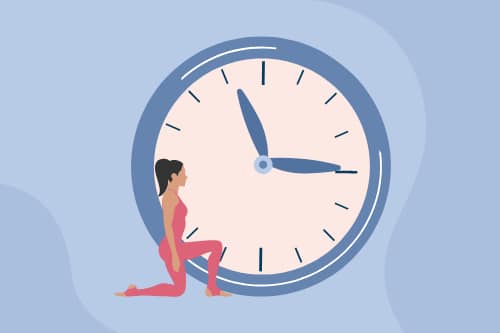
If you are a beginner, start with practising Vajrasana for 3-4 minutes. As you progress, you can increase the duration to 5-7 minutes. Depending on your strength and comfort, you can increase the duration of the asana to 15-20 minutes or even more.
You can practice the diamond pose after lunch or dinner. You can also practice this pose on an empty stomach.
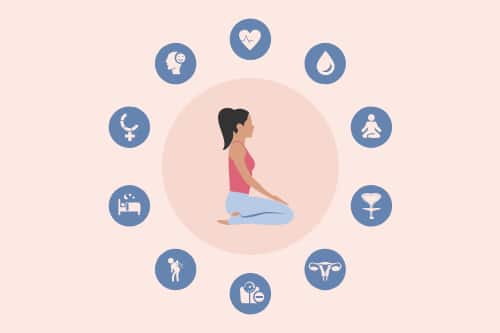
Vajrasana has numerous positive health benefits. Regular practice of this asana can greatly improve your physical and mental health.
Perform slow and rhythmic breathing along with the asana to reap more benefits of this excellent yoga pose.
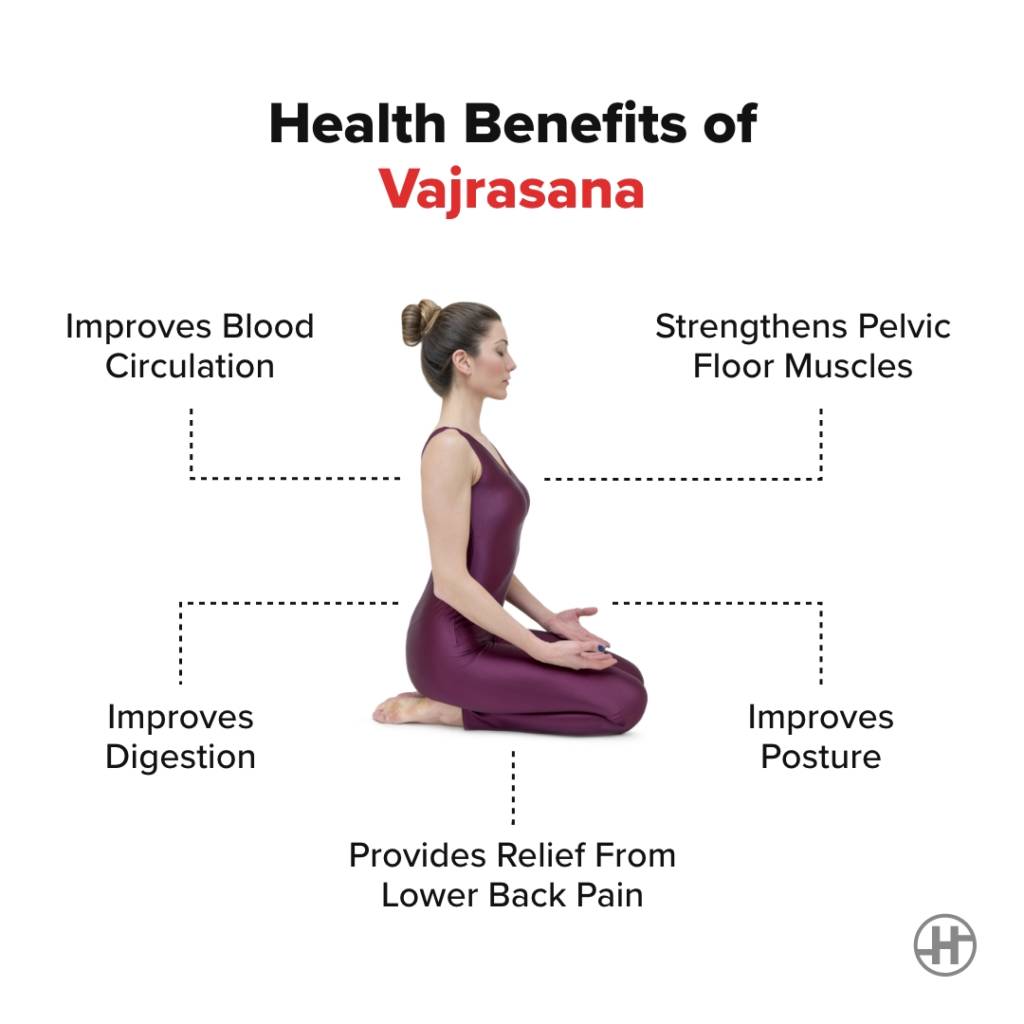
Vajrasana is great for blood circulation. It specifically improves the blood flow in the pelvic region.
Breathing simultaneously regulates blood circulation in the entire body.
Vajrasana requires your back to be firm and straight. This helps to improve your posture and results in better absorption of the benefits offered by this asana.
Vajrasana stimulates the digestive organs, including the stomach, intestines, and pancreas. It obstructs blood flow to our legs and thighs and increases it in our stomach area, thus improving our bowel movements and relieving constipation.
Research shows that vajrasana also helps to get rid of flatulence (gas) and acidity. Hence, it ensures better absorption of nutrients by your body. It is good to perform Vajrasana after meals since it helps in digestion.
Vajrasana helps to strengthen your lower back muscles and thus provides relief from occasional pain and discomfort.
It also helps to relieve pain caused by sciatica. According to studies, regular practice of Vajrasana can help you strengthen your lower back.
As per studies, vajrasana increases blood circulation in the pelvis and strengthens our pelvic floor muscles. It is also very useful for women suffering from stress urinary incontinence.
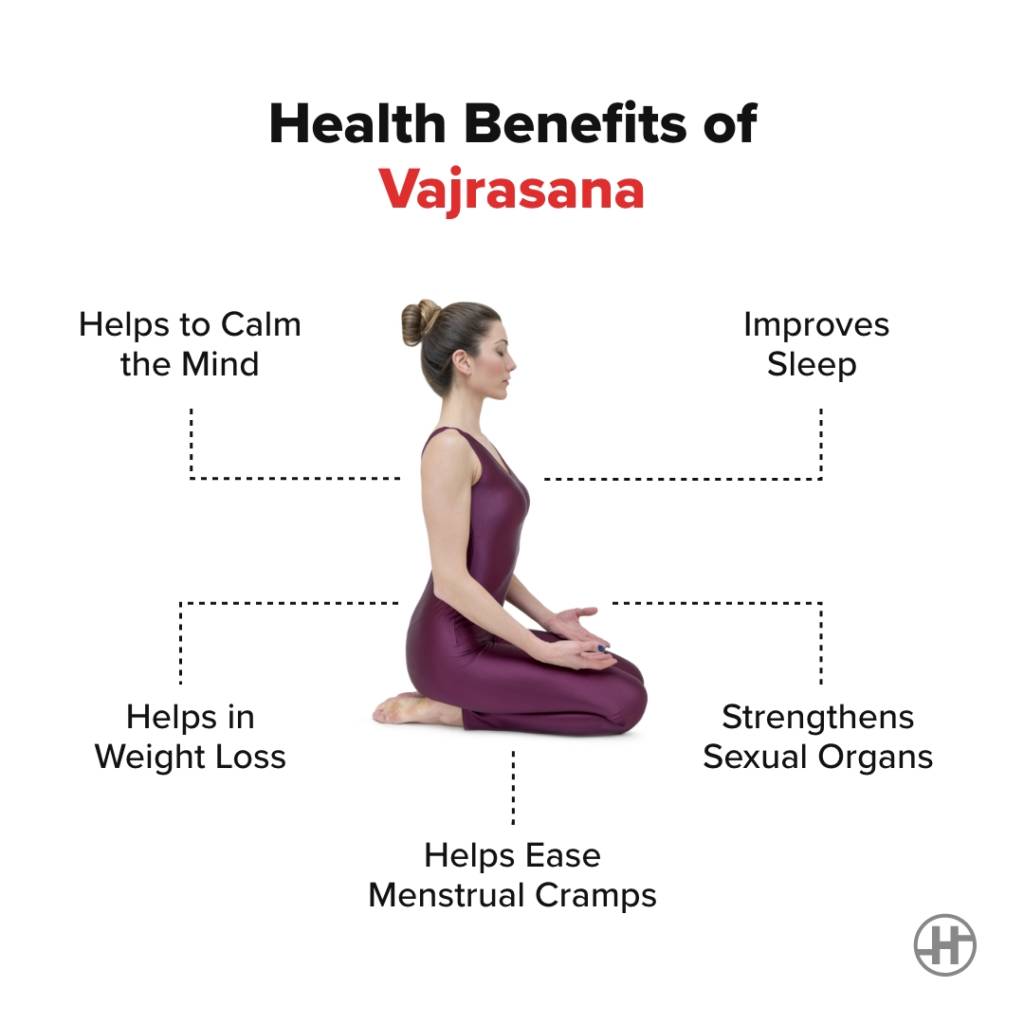
Regular practice of Vajrasana reduces stress and improves concentration.
According to research, vajrasana help deals with depression and anxiety. This asana has a grounding and calming effect on the mind. Practising Vajrasana can promote relaxation and a sense of tranquillity. As a result, it even improves your quality of sleep and overall life.
Regular practice of Vajrasana can assist in weight management. It helps in improving metabolism and digestion, which can contribute to maintaining a healthy weight.
Vajrasana improves blood circulation and nourishes the reproductive organs. Thus, strengthening the sexual organs in both men and women. In addition to improving better sexual performance, it has a positive impact on reproductive health.
Scientific studies show that vajrasana also helps ease menstrual cramps by improving blood flow in the pelvis.
Vajrasana is a beneficial yoga pose that offers multiple health advantages. It enhances blood circulation, particularly in the pelvic area, and promotes better digestion. By improving posture, it aids in the absorption of its benefits. Vajrasana strengthens the lower back and pelvic floor muscles, providing relief from pain and strengthening sexual organs. It also calms the mind, reduces stress, improves sleep, aids in weight loss, and alleviates menstrual cramps. Regular practice of Vajrasana enhances overall well-being and reproductive health, making it a valuable addition to one’s routine.
There is a more intense version of the basic Vajrasana called ‘Supta Vajrasana’ or the reclined thunderbolt posture. To perform this version, follow these steps.
Yoga is an ancient practice, this art of yoga is believed to have its roots in India.
Yoga is a powerful tool to enhance one’s physical strength, mental capacity, improve stamina and lung capacity. Yoga is greatly beneficial for both men and women. It helps to improve hormonal conditions in women. It has been proved by various studies that yoga helps with menstrual cramps and even PCOS.
With regular yoga practice, you can increase your flexibility and muscle strength.
Vajrasana is one of the easiest yet most beneficial yoga asanas. It is one of the most effective meditative poses for achieving higher concentration levels.
Yogis sit in this pose for hours during meditation and ‘Dhyaan.’ The pose is a part of many praying rituals. This alone speaks for the calm and tranquillity it provides to the mind.
The best thing about Vajrasana is that, unlike other yoga poses, you can perform this immediately after a meal. It is most efficient when you perform it on a full stomach as it helps in digesting the food.
Vajrasana is a base pose for many other asanas like Gomukhasana, Ustrasana, and Shirshasana.
This asana is suitable for all kinds of people. However, take precautions if you have knee-related issues or some leg injury. Consult your Yoga Instructor before performing Vajrasana.
It is a great asana to begin your yoga practice. Just sitting in Vajrasana for a few minutes can give you amazing health benefits. So grab your yoga mat, sit in Vajrasana and experience all the great health benefits of this yoga asana.
Disclaimer: The purpose of this article is just to disperse knowledge and raise awareness. It does not intend to replace medical advice from professionals. For further information please contact our certified nutritionists Here
A. Vajrasana also called Thunderbolt or Diamond pose is one of the simplest yoga asanas. This is the best asana to cure any stomach-related problems. Vajrasana is the only asana in yoga that you can perform immediately after a meal. People of any age can perform this asana easily. It has great health benefits and strengthens the whole body.
A. Adamantine Pose, Pelvic pose, Thunderbolt pose, Diamond pose and Kneeling pose are the different names of Vajrasana.
A. If you are a beginner, start with practising Vajrasana for 3-4 minutes. As you progress, you can increase the duration to 5-7 minutes. You can practice Vajrasana after lunch or dinner. You can also practice this pose on an empty stomach. Depending on your strength and comfort, you can increase the duration of the asana to 15-20 minutes or even more.
A. Performing Vajrasana helps our digestive system in many ways. It obstructs blood flow to our legs and thighs and increases it in our stomach area, thus improving our bowel movements and relieving constipation. Vajrasana also helps us to get rid of flatulence (gas) and acidity. It ensures better absorption of nutrients by our body. It is good to perform Vajrasana after meals since it helps indigestion.


Very helpful. Thankyou!
Beautifully explained. Only missing thing is benefits for diabetes.